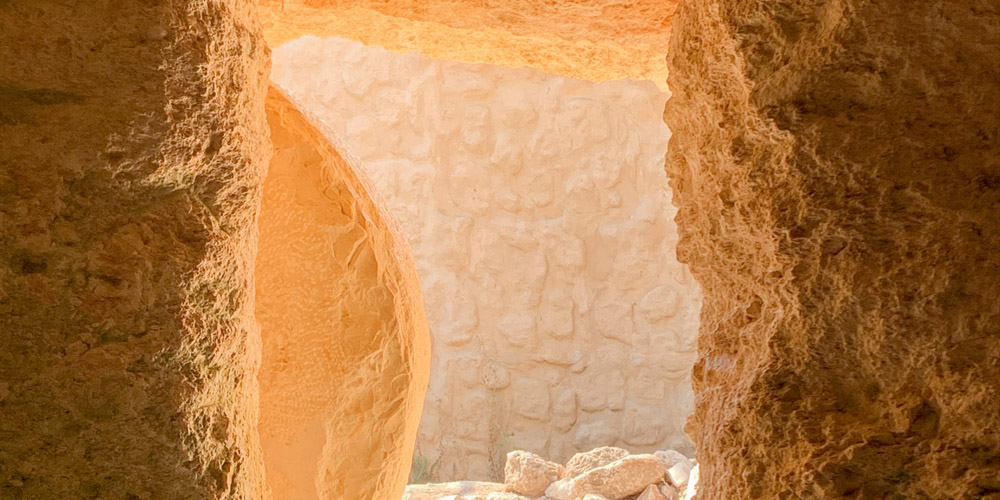Ronald Gregor Smith supplies the world’s answer to this question: “So far as historicity is concerned…We may freely say that the bones of Jesus lie somewhere in Palestine, but the Christian faith is not destroyed by this admission”1 Yet, contrary to this conclusion, the apostle Paul claims that the Christian faith stands or falls on the resurrection of Jesus Christ (1 Cor. 15:12-19). Without His resurrection the Church could not have been formed—there would be no life for us to be baptized into. As a result, believers would have no spiritual life or power to experience, and no hope of glorification and life in heaven either (1 Cor. 15:17-19). Christ dying for our sins at Calvary would have no practical value unless we are also able to possess His life. Thus, Christ’s death, without resurrection, is not a good news message (1 Cor. 15:3-4), but rather a miserable substitute.
Evidences for the Resurrection of Jesus Christ:
Eyewitness accounts
Scripture records five eyewitness accounts of seeing Jesus Christ alive on resurrection day (John 20:11-18; Matt. 28:8-10; 1 Cor. 15:5; Luke 24:13-32; 24:36-43) and then at least five more over the next forty days before His ascension into Heaven (John 20:26-31; 1 Cor. 15:6-7; John 21; Acts 1:2-12). Indeed, Paul states that at least 500 people saw Him at one time, perhaps in Galilee (1 Cor. 15:6).
Who Would Want to Steal Christ’s Body?
The Romans would not want to remove Jesus’ corpse from its tomb, as their main objective was to maintain civil order during the Jewish feasts which often caused Jerusalem’s population to swell fourfold. Because Jesus publicly foretold of His resurrection, the Jews wanted to ensure His body did not go missing after three days, which is why they requested Pilate to set guards at His tomb. Christ’s disciples had no reason to steal His body; otherwise, they would have suffered a lifetime of misery for a lie. Fanatics may die for a religious cause, but not for what they know is not true. Additionally, lying would have grieved the Holy Spirit (Eph. 4:29-30); why then did the Holy Spirit so wonderfully bless their ministries and enable them to perform miracles.
Radically Changed Lives
The disciples were transformed from common laborers to zealous men that thought nothing of losing their lives for Christ—they saw, heard, and felt the risen Savior and never got over that experience. They willingly risked their lives in obedience to Christ’s command to be His witnesses throughout the world. John was banished and imprisoned on the Isle of Patmos. James was executed by Herod. Nero crucified Peter upside down. Andrew was crucified in Greece. Thomas was pierced by the spears. Philip was put to death for converting the wife of a Roman proconsul. Matthew was stabbed to death in Ethiopia. Simon was killed in Persia for refusing to sacrifice to the sun god. James, the half-brother of Christ was stoned and then clubbed to death at the temple. He was not converted until after he personally spoke to his resurrected half-brother and Savior (John 7:5; Acts 1:14; 1 Cor. 15:7). He penned the book of James before his death. Then we have Paul, a prominent Jewish leader that had Christians imprisoned and executed for their faith. But after meeting the glorified Savior on the road to Damascus (Acts 9), he converted to Christianity, was appointed an apostle to the Gentiles by Christ, and then suffered much persecution fulfilling that calling. He wrote at least thirteen books in our Bibles and after finishing his course, was beheaded by Nero.
Signs and Wonders at Pentecost
Peter explained to the Jews that Jesus’ ministry had been approved by God through the evidence of miracles. The signs and wonders that they were witnessing at Pentecost were continuing in Christ’s authority, which meant God had raised Him from the dead (Acts 2:22-24). If Christ did not experience resurrection from where did the apostles get the power to do the miracles recorded in Acts?
Difficulties to Explain:
The Days in the Tomb
Speaking of His death, the Lord said that He would “be raised the third day” after being killed (Matt. 16:21), but also that He would “be killed, and after three days rise again” (Mark 8:31). The Lord implies that these are interchangeable expressions though appearing contradictory to us. Most references to the resurrection state that it would occur on the third day (Matt. 17:23; 20:19; Luke 9:22; 18:33) or in the third day (John 2:19-22). However, while speaking to the Pharisees, the Lord referred to the sign of Jonah to foretell of His death and resurrection: “For as Jonah was three days and three nights in the belly of the great fish, so will the Son of Man be three days and three nights in the heart of the earth” (Matt. 12:40). The Pharisees later repeated Christ’s statement to Pilate, “after three days I will rise” (Matt. 27:63), but then they asked for a guard “until the third day” (Matt. 27:64). If the term, “after three days,” was not interchangeable with “the third day,” then the Pharisees would have asked that the tomb be guarded four days. The term “one day and one night” was a Jewish idiom indicating a day, even when only a part of a day was indicated (e.g. Gen. 42:74; 1 Sam. 30:12). In summary, the terms “three days and nights” and “three days” were common expressions the Jews used interchangeably.
The Number of Angels in the Tomb?
Matthew and Mark describe one angel speaking to the women, while Luke and John state that two angels were in the tomb. The answer: There were two angels in the tomb, but only one served as the spokesman.
The Time the Women Came to the Tomb?
Mark’s account has the women coming to the tomb at the rising of the sun, while John states that Mary Magdalene came to the tomb when it was yet dark. The best explanation: the women left while it was yet dark and arrived at the tomb while the sun was rising. Since they were coming from Bethany, and perhaps Jerusalem, it would have taken some time to get to the tomb.
The Differing Eye Witness Accounts Resurrection Morning
Each gospel writer presents Christ from a different perspective. If all the writers gave exactly the same story, same order, same details, we would immediately become suspicious that the records were the copies of a single account. But because some events are recorded in some gospels and not others, we have proof of multiple accounts and not just one story repeated. For example, only Matthew records Christ’s first appearance to the women, while only Luke records the events transpiring on the Emmaus road. Luke does not record Mary Magdalene’s visit to the tomb. Only John and Luke record Christ’s appearance in the upper room on resurrection day. Given all the information recorded in the gospels, there is a reasonable construction of all that took place on resurrection morning without contradiction.
Conclusion
Jesus Christ declared to the Pharisees that His resurrection would prove that He was the Son of God (Matt. 12:39-40; Rom. 1:4). Jesus Christ, the only begotten Son of God, was the first fruits of eternal resurrection and is now with His Father in heaven (Heb. 1:5; Rev. 3:21). There have been many skeptics (e.g., Frank Morrison, Josh McDowell, and C. S. Lewis) who have tried to disprove the resurrection of Jesus Christ and in the process came to the truth and were saved. The doctrine of Christ’s resurrection is essential to the Christian faith and the evidence for the resurrection of the Lord Jesus Christ is overwhelming!
Endnotes:
1. Secular Christianity, Collins, 1966; p. 103

